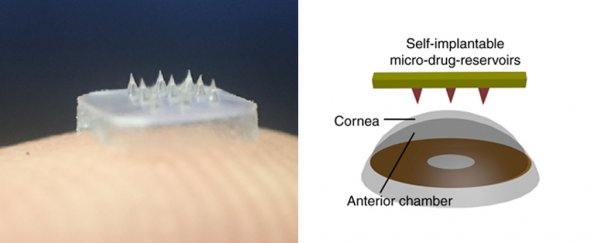An eyepatch lined with dissolvable needles may sound like a cruel form of torture, but researchers say the invention could fundamentally change the way that we treat eye disease.
The human eye is a delicate structure defended by multiple protective layers. These safeguards keep pathogens and other dangerous materials out of the eye, which is usually a good thing.
But when the eye is plagued by disease, like glaucoma or macular degeneration, these barriers become obstacles that make delivering the appropriate medicine a challenge.
At the moment, eye diseases are generally treated using eye drops or needles, both of which have their downsides. Eye drops can't deliver enough medicine at once, and suffice to say, needles around the cornea can be risky.
Which brings us back to the eyepatch of anguish. Researchers have now come up with a new strategy that uses dissolvable needles to deliver medicine to the cornea - the transparent layer at the front of the eye.
By penetrating the protective surface tissue of the cornea, these needles work like micro-reservoirs for drugs, delivering a controlled amount of medicine at home over an extended period of time.
So far, the invention has only been tested on mice, but the results look promising and the way it works is not nearly as unpleasant as it appears at first.
With a "gentle and brief thumb pressing" a span of microneedles resting on a base can be applied to the front of the eye, like a patch on the skin.
Even though this might sound horrifically painful, the needles are so little they actually caused no pain in the mice, and they are not going to draw blood, either. In fact, the researchers say the eye patch is "as easy as wearing a disposable contact lens without causing discomfort or requiring high skills."
Once the patch is in place, fluid from the eye begins to seep into the spaces between the needles, slowly eroding away the material that holds them together. The base is removed at this point, leaving the microneedles embedded in the cornea.
The outer layer surrounding these microneedles then begins to dissolve, delivering an initial strong dose of medicine. Over the next few days, the rest of the needle follows suit, eroding completely and administering the remaining medicine.
 (Nature Communications)
(Nature Communications)
To prove the efficiency of their concept, the researchers tested the eye patch on lab mice with corneal neovascularization (NV), a form of oxygen deprivation in the cornea that can cause obscured vision.
Infusing the needles with an antibody treatment, the researchers found that their strategy was extremely effective at treating the disease, healing 90 percent of the neovascular areas.
The unique delivery system is not only localised, the researchers claim it is minimally invasive and much more efficient than topical eye drops or the fast release of drugs through regular needles.
Of course, there needs to be clinical testing to ensure that there aren't any undesirable outcomes in humans. But so far, the treatment looks promising. Given that the medicine is released gradually over time, it's plausible the systemic side-effects won't be any worse than current treatments that rely on large, once-off doses of medicine.
"We believe this approach could be paradigm-shifting for long-term home-based treatment and management of various eye diseases," the authors conclude.
Now, they just have to convince some humans to stick it on their eye.
This study has been published in Nature Communications.
